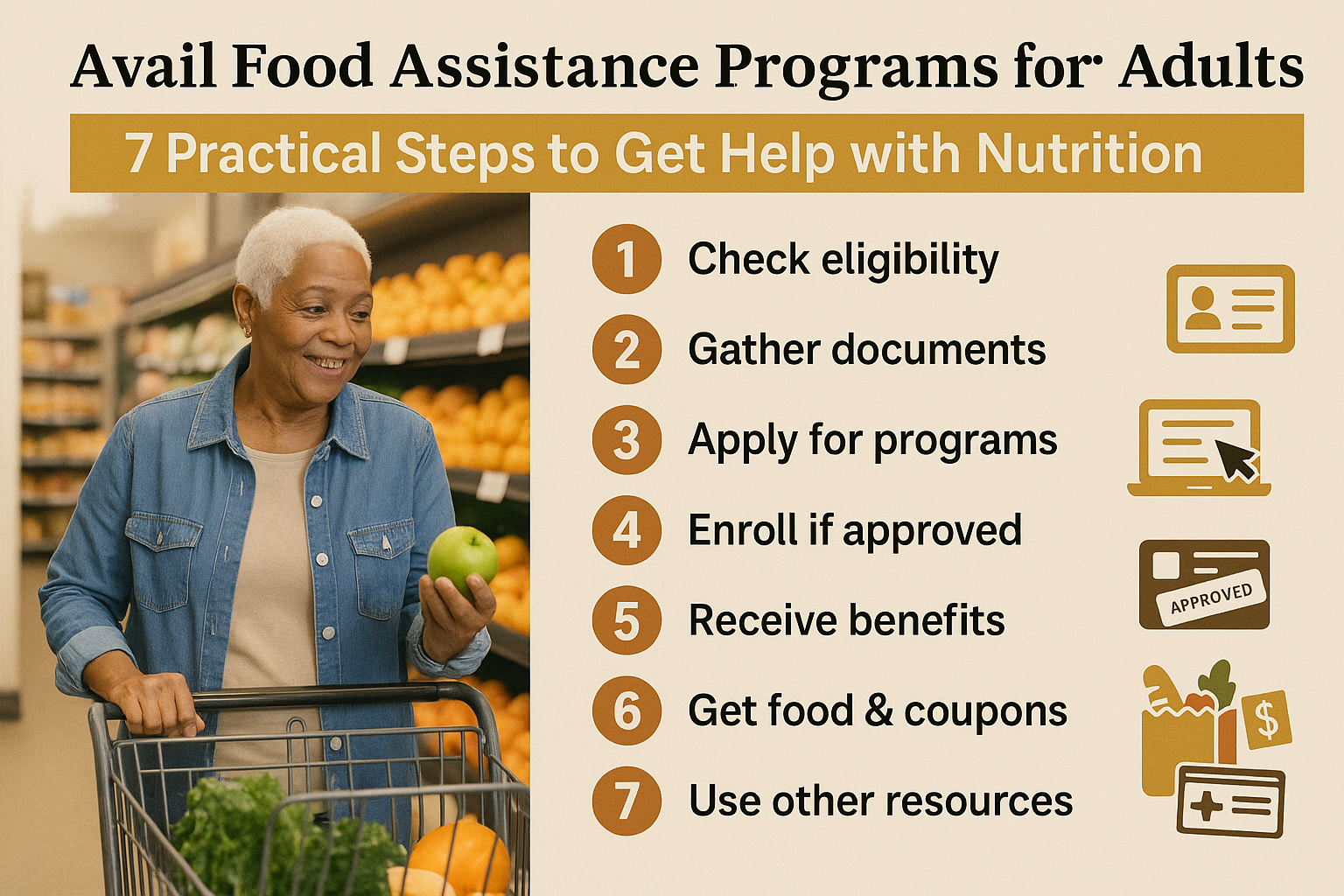Avail Food Assistance Programs for Older Adults: If you’re 60 or older and money’s tight, you don’t have to go hungry. Federal and state programs exist specifically to help older adults buy healthy food, get grocery coupons, and receive monthly food packages — plus there are related supports (like SNAP and some Medicare Advantage “flex” benefits) that can stretch a senior budget even further. This guide shows you, step-by-step, how to check eligibility, apply, and use the main programs so you can access the food assistance you need — fast.
Quick snapshot — the programs that most often help seniors
- Senior Farmers’ Market Nutrition Program (SFMNP): seasonal coupons you can spend on fresh fruits, vegetables, herbs, and honey at participating farmers markets, roadside stands, and community farms. (USDA Food and Nutrition Service)
- Commodity Supplemental Food Program (CSFP): monthly USDA food packages distributed through local agencies (some states offer delivery). (USDA Food and Nutrition Service)
- SNAP (Supplemental Nutrition Assistance Program): broader monthly benefits (formerly “food stamps”) for low-income households — seniors have special rules and simplified options in many states. (USDA Food and Nutrition Service)
- Medicare Advantage “flex” cards or grocery allowances: some Medicare Advantage plans offer a flex card or grocery allowance as a supplemental benefit; recent federal guidance clarifies how those cards are treated for public-benefit eligibility. Check your insurer for details. (Center for Medicare Advocacy, Elderplan)
These programs are administered either federally (USDA/FNS) or by state/local agencies — so availability and exact rules (especially for SFMNP and CSFP) vary by state. (USDA Food and Nutrition Service)
Step 1 — Quick eligibility check (do this first)
Most senior food programs share similar basic tests:
- Age: generally 60 years or older for SFMNP and CSFP. (USDA Food and Nutrition Service)
- Income: many programs use a test at or below 185% of the federal poverty guidelines (exact thresholds and household counts vary by year and state). If you already receive SNAP, Medicaid, or other means-tested benefits you may automatically meet the income screen in some states. (USDA Food and Nutrition Service)
If you pass those quick checks, you’re a good candidate to apply or to ask your state agency for help verifying eligibility.
Step 2 — Gather the documents that speed approval
Before you call or go online, have these handy:
- Photo ID (driver’s license, state ID, passport)
- Proof of age (birth certificate, Medicare/SSA card) if ID doesn’t show your birthdate
- Proof of residence (utility bill, lease, mail)
- Proof of income (recent pay stubs, award letters for SNAP/SSI/SS benefits, or the most recent tax return)
Local agencies accept digital photos of documents in many places — ask when you call.
Step 3 — How to apply for SFMNP and CSFP (practical)
Because SFMNP and CSFP are run locally, the fastest route is to contact your state program office:
- Find your state SFMNP contact through USDA/FNS (the SFMNP contact page shows which states participate and lists local agencies). If your state participates, they’ll tell you when coupons are issued and where to pick them up. (USDA Food and Nutrition Service)
- Find your CSFP local agency via the CSFP state/local agency directory to learn pickup/delivery rules and the monthly food package schedule. Some states allow home delivery for homebound seniors. (USDA Food and Nutrition Service)
- Apply directly at the local agency (many accept phone, in-person, or online pre-screenings). Ask whether there’s a waitlist and whether delivery is offered for those with mobility issues.
Tip: SFMNP is seasonal (farmers-market season) and runs through participating local sites — call early in the season.

Step 4 — If you don’t see SFMNP/CSFP in your state, try SNAP
Not all states participate in SFMNP or CSFP, but SNAP is available nationwide and often helps more: monthly benefits are loaded to an EBT card and can be used at most grocery stores and many farmers markets. Older adults sometimes get special simplified application processes and higher deductions for medical expenses. Apply through your state SNAP office (online or by phone). (USDA Food and Nutrition Service, National Council on Aging)
If you’d like, I can pull the SNAP application page for your state — give me your ZIP code and I’ll fetch the direct link.
Step 5 — Check Medicare Advantage flex cards (if you have Part C)
Some Medicare Advantage plans offer a flex card or grocery allowance to pay for specified items (groceries, meal delivery, OTC items). Recent federal clarification from CMS and advocates confirms these ARE plan benefits and guidance was issued to limit counting flex cards as income for public-benefit eligibility determinations — but rules and availability depend on your plan. If you have Medicare Advantage:
- Call your plan’s member services and ask if they offer a flex/grocery card and what items it covers. (Center for Medicare Advocacy, Elderplan)
- Ask whether the plan’s flex benefit will affect SNAP or other eligibility (CMS guidance aims to exclude the card from income calculations, but local agencies can vary — get the plan’s written benefit description).
Step 6 — Shopping & using benefits (practical pointers)
- SFMNP coupons: use only with authorized farmers/markets — ask the local SFMNP office for a vendor list. (USDA Food and Nutrition Service)
- CSFP packages: pick up at the agency site or accept delivery where available — the package includes shelf-stable and fresh items targeted for older adults. (USDA Food and Nutrition Service)
- SNAP/EBT: many markets accept EBT and some offer SNAP doubling programs (matching SNAP purchases for fruits and vegetables). Check local market programs for extra value. (USDA Food and Nutrition Service)
Always keep receipts and the agency’s contact info — if a store or vendor can’t accept your benefit, your local agency can help resolve it.
Step 7 — If you need help applying or want a fast check
- Call 2-1-1 or your local Area Agency on Aging for application assistance and referral to local food programs and meal delivery. Community organizations often assist with forms and transportation.
- If you want, tell me your ZIP code and I’ll find the local SFMNP/CSFP contacts and your state SNAP application page so you can apply right now.
Official resources (click to verify and apply)
- USA.gov — Senior food programs overview: https://www.usa.gov/senior-food-programs. (USAGov)
- USDA FNS — Senior Farmers’ Market Nutrition Program (SFMNP): https://www.fns.usda.gov/sfmnp/senior-farmers-market-nutrition-program. (USDA Food and Nutrition Service)
- USDA FNS — SFMNP state/local contacts: https://www.fns.usda.gov/sfmnp/program-contacts. (USDA Food and Nutrition Service)
- USDA FNS — Commodity Supplemental Food Program (CSFP): https://www.fns.usda.gov/csfp/commodity-supplemental-food-program. (USDA Food and Nutrition Service)
- USDA FNS — SNAP eligibility and how to apply (state links): https://www.fns.usda.gov/snap/recipient/eligibility. (USDA Food and Nutrition Service)
- Medicare advocacy summary of CMS guidance on MA flex cards: https://medicareadvocacy.org/cms-clarifies-ma-flex-cards/. (Center for Medicare Advocacy)
Disclaimer: This article is informational and does not replace legal, medical, or benefits counseling. Program rules, income limits, and participating states change periodically — verify eligibility and application steps with the official links above or your state agency before you apply. If you’d like, share your ZIP code and I’ll fetch the exact local agency contact and application link for the program that fits you best. Avail Food Assistance Programs for Older Adults: 7 Practical Steps to Get Help with Nutrition (Updated Aug 2025). All images used in this article are royalty‑free or licensed for commercial use and are provided here for illustrative purposes.
